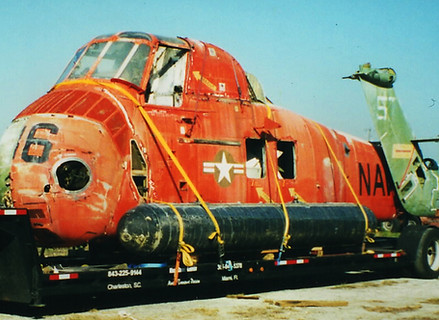
1955 Sikorsky S-58 / UH-34d - BUNO: 147173

The Sikorsky H-34 (company designation S-58) is a piston-engined military helicopter originally designed by American aircraft manufacturer Sikorsky as an anti-submarine warfare (ASW) aircraft for the United States Navy. It has seen extended use when adapted to turbine power by the British licensee as the Westland Wessex and Sikorsky as the later S-58T.
The Sikorsky S-58 was developed as a lengthened and more powerful version of the Sikorsky Model S-55, or UH-19 Chickasaw, with a similar nose, but with a tail-dragger rear fuselage and landing gear, rather than the high-tail, 4-post pattern. It retained the nose-mounted radial reciprocating engine with the drive shaft passing through the cockpit placed high above the cargo compartment.
The aircraft first flew on 8 March 1954. The first production aircraft was ready in September and entered in service for the United States Navy initially designated HSS-1 Seabat (in its anti-submarine configuration) and HUS-1 Seahorse (in its utility transport configuration) under the U.S. Navy designation system for U.S. Navy, United States Marine Corps (USMC) and United States Coast Guard (USCG) aircraft. The U.S. Army and Marine Corps, respectively, ordered it in 1955 and 1957. Under the United States Army's aircraft designation system, also used by the United States Air Force, the helicopter was designated H-34. The U.S. Army also applied the name Choctaw to the helicopter. In 1962, under the new unified DoD aircraft designation system, the Seabat was redesignated SH-34, the Seahorse as the UH-34, and the Choctaw as the CH-34.
Roles included utility transport, anti-submarine warfare, search and rescue, and VIP transport. In its standard configuration, transport versions could carry 12 to 16 troops, or eight stretcher cases if utilized in the MedEvac role, while VIP transports carried significantly fewer people in much greater comfort. A small fleet of H-34 helicopters served U.S. Presidents Dwight D. Eisenhower and John F. Kennedy from 1958 to 1961 using the call sign Army One.
A total of 135 H-34s were built in the US and assembled by Sud-Aviation in France, 166 were produced under licence in France by Sud-Aviation for the French Air Force, Navy and Army Aviation (ALAT). The CH-34 was also built and developed under license from 1958 in the United Kingdom by Westland Aircraft as the turboshaft engined Wessex which was used by the Royal Navy and Royal Air Force. The RN Wessex was fitted out with weapons and ASW equipment for use in an antisubmarine role. The RAF used the Wessex, with turboshaft engines, as an air/sea rescue helicopter and as troop transporter. Wessexes were also exported to other countries and produced for civilian use.
H-34s served, mostly as medium transports, on every continent with the armed forces of 25 countries. It saw combat in Algeria, the Dominican Republic, Nicaragua, and throughout Southeast Asia. Other uses included saving flood victims, recovering astronauts, fighting fires, and carrying presidents. It was the last piston-engined helicopter to be operated by the United States Marine Corps, having been replaced by turbine-powered types such as the UH-1 Huey and CH-46 Sea Knight. A total of 2,108 H-34s were manufactured between 1953 and 1970.


The Connecticut Air & Space Center's Sikorsky H-34D Serial#: 147173 was recovered from a business in Florida in 2001. Our specific example is a Vietnam veteran with combat time on it's airframe while serving aboard the USS Kitty Hawk. The "Seahorse" is in storage until other projects are completed. She was moved to our ramp at the beginning of 2025 when a wind storm knocked her over causing some minor damage. On Saturday Nov 22, 2025 the UH-34D was put back on her landing gear for the first time in over 30 years.

